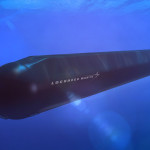
WHY THIS MATTERS
It is inevitable that more of the world’s military platforms will become autonomous, and America’s submarines are about to get a huge upgrade.
As part of its plan to turn undersea drones from remote controlled tools and toys into fully enrolled members of the fleet, last week the US Navy (USN) awarded a $45 million contract to Lockheed Martin to design what the pair are catchily calling the Orca Extra Large Unmanned Undersea Vehicle (XLUUV), and if all goes well then the new UUV would be one of the largest in the world, and put Boeing and their own recent UUV plans, which include teaming up with America’s largest shipbuilder Huntingdon Ingalls Industries to build America’s next generation of UUV’s, on notice.
At the moment Lockheed and the USN are focused on a two phase competition to produce up to nine vehicles, and the plan is that the XLUUV Orca will be an “autonomous submarine capable of carrying out multiple missions without a human crew or the need for continuous remote supervision.”
Underwater drones have revolutionised undersea warfare as much as they have aerial combat, and it’s clear from a spate of recent announcements, from the building of autonomous undersea drone highways and “service stations,” to the rapid development of new platforms, like Russia’s autonomous “nuclear capable” submarine, and even the emergence of new longer life batteries that now drink sea water and not air, that the trend is here to stay. It’s also increasingly clear that it will only accelerate in the coming years.
Unfortunately though the current generation of UUV’s, unlike their surface ship cousins such as the USN’s “autonomous capable” 600ft long USN Zumwalt destroyer and the fully autonomous Sea Hunter, only have limited autonomy which means that, as far as the USN is concerned they don’t deliver much of a cost saving because they still need surface ships and submarines to transport, launch and retrieve them.
The Orca though won’t just be larger than present UUV’s, it’ll be multiple times larger, and while no exact dimensions have been released yet think small to medium submarine sized and you’ll probably be in the ballpark, and naturally its open architecture specifications call for a “modular, long range autonomous vehicle with a reconfigurable payload bay.”
When operational, the new subs will be able to leave base autonomously, travel to their duty stations and remain there until needed while deploying payloads and communicating periodically with headquarters until their mechanical hearts are content, and then at the end of its mission, they’ll return home under their own control.
The idea is that this will not only make the Orca cheaper to operate, but that it will also be able to carry out strategic missions without putting sailors at risk. In this way, it becomes what’s known in the game as a “force multiplier” for intelligence, surveillance, and reconnaissance, mine countermeasures, indication and warning notification, and as an anti-submarine warfare training platform.
No timetable has been announced to create the first Orca yet but the program is likely to get kick started next year, just in time for it to join Lockheed’s other autonomous vehicle in action, the autonomous hypersonic SR-72 that was announced, and demonstrated earlier this year.


















